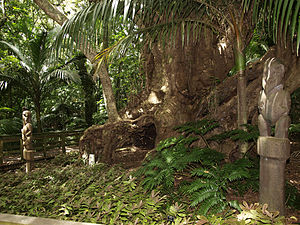Hukutaia domain
The Hukutaia Domain is a 4.5 hectare park in Opotiki in the Bay of Plenty region with trees and other plants naturally occurring in New Zealand , some of which are endemic . The park is located five miles south of downtown Opotiki in the rising hills of the Waioeka River valley .
history
In 1913, a very old Puriri tree was discovered in what is now the park . The remains of human bones were found in a cavity at the base of the tree. Investigations have shown that this tree was used by the Māori for burial. A few years after their death, the bones of the deceased were dug up using a special ritual, coated with iron oxide and then buried in the tree cavity in such a way that they could not be found by enemies. The ceremonies sometimes included the sacrifice of slaves. The tree and its surroundings were sacred to the Maori and anyone who would desecrate this place would be doomed to death according to the will of the tribal gods.
Representatives of the Iwi Whakatōhea and the city of Opotiki tried to put the tree under protection. After the government bought the Woodlands Estate in 1918 for the rehabilitation of soldiers who had returned from the war, the area with the tree was placed under protection. In July 1926, after it was expanded through acquisitions, it was declared public property and was given the name Hukutaia Domain . A committee was set up to look after the maintenance and care of the tree and the surrounding area. It is estimated that the " Burial Tree " ( funeral tree ) is over 2,000 years old.
In 1933 the amateur botanist Norman Potts became chairman of the board of directors. He made tours through New Zealand, collecting native trees and plants and planting them on the Hukutaia Domain. Plants of European origin were considered "weeds" and were banned. He died on November 16, 1970 at the age of 84. Marc Heginbotham took on this kind of homeland care for another twenty years. Today volunteers are doing this under the supervision of the Hukutaia Domain Advisory Committee .
today
Today the park looks like a New Zealand jungle , densely overgrown and seemingly left in its natural development. The numerous small signs to identify and name the species and a few explanatory panels indicate the human influence.
The park is now home to an estimated 7,000 specimens from 1,500 different species. By far the most outstanding specimen is the Puriri ( Vitex lucens ) with its great age, a circumference of around 21 meters and a height of a little over 21 meters.
Web links
- Hukutaia domain . Opotiki District Council, archived from the original onFebruary 9, 2013; accessed on January 20, 2016(English, original website no longer available).
Individual evidence
-
↑
Archived website from 2014 contains more information
- Hukutaia domain . Opotiki District Council, archived from the original onMarch 31, 2014; accessed on January 20, 2016(English, original website no longer available).
- Hukutaia domain . Opotiki District Council, archived from the original onJanuary 21, 2016; accessed on April 18, 2019(English, original website no longer available).

